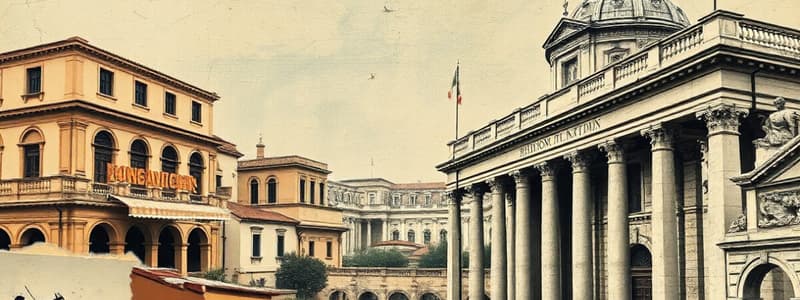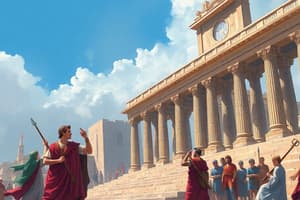Podcast
Questions and Answers
Which of the following geographic features facilitated the unification of Italy?
Which of the following geographic features facilitated the unification of Italy?
- The absence of significant geographic barriers (correct)
- A lack of broad, fertile plains
- Very rugged Apennine Mountains
- The presence of small, isolated valleys
What action did Rome take against Carthage after the death of Hannibal?
What action did Rome take against Carthage after the death of Hannibal?
- Rome ignored Carthage, considering it no longer a threat.
- Rome offered Carthage a peace treaty with lenient terms.
- Rome sought to rebuild Carthage as a trading partner.
- Rome destroyed Carthage, fearing its continued rivalry. (correct)
What was the primary reason for Julius Caesar bringing civil war to Rome?
What was the primary reason for Julius Caesar bringing civil war to Rome?
- Caesar sought to expand Roman territory further into Gaul.
- Caesar was seeking revenge for a personal grievance against the Senate.
- Caesar aimed to overthrow the existing Roman government completely.
- Caesar challenged the authority of the Senate by crossing the Rubicon River. (correct)
What was the key achievement of Augustus in establishing a stable government?
What was the key achievement of Augustus in establishing a stable government?
Which of the following is NOT a common basic principle of law developed by the Romans?
Which of the following is NOT a common basic principle of law developed by the Romans?
How did Christianity spread from a Jewish sect to a global religion?
How did Christianity spread from a Jewish sect to a global religion?
What was the significance of Constantine's Edict of Milan?
What was the significance of Constantine's Edict of Milan?
Which of the following DID NOT contribute to the fall of the Roman Empire?
Which of the following DID NOT contribute to the fall of the Roman Empire?
What was a significant action Rome took against Carthage after the death of Hannibal?
What was a significant action Rome took against Carthage after the death of Hannibal?
Which of the following is NOT a basic principle of law developed by the Romans?
Which of the following is NOT a basic principle of law developed by the Romans?
What was the main factor contributing to the stability of the Roman Empire during the Pax Romana?
What was the main factor contributing to the stability of the Roman Empire during the Pax Romana?
Why was the Edict of Milan significant to the growth of Christianity?
Why was the Edict of Milan significant to the growth of Christianity?
Which of the following was NOT a major feature of Roman architecture?
Which of the following was NOT a major feature of Roman architecture?
How did the Byzantine Empire serve as a buffer for Europe?
How did the Byzantine Empire serve as a buffer for Europe?
What was the key factor that contributed to the permanent split between the Roman Catholic Church and the Byzantine Church?
What was the key factor that contributed to the permanent split between the Roman Catholic Church and the Byzantine Church?
What significant development in the Roman Empire helped to reinforce the strength of the Byzantine Empire?
What significant development in the Roman Empire helped to reinforce the strength of the Byzantine Empire?
Flashcards
Geographic features of Italy
Geographic features of Italy
Italy's geography facilitated its unification due to flat plains and gentle mountains.
Dictator in Rome
Dictator in Rome
A leader appointed for a limited time during wartime to make swift decisions.
Pax Romana
Pax Romana
A 200-year period of peace and stability in the Roman Empire.
Aqueducts
Aqueducts
Signup and view all the flashcards
Spread of Christianity
Spread of Christianity
Signup and view all the flashcards
Justinian's Code
Justinian's Code
Signup and view all the flashcards
Church schism
Church schism
Signup and view all the flashcards
Diocletian and Constantine
Diocletian and Constantine
Signup and view all the flashcards
Carthage's downfall
Carthage's downfall
Signup and view all the flashcards
Rubicon River
Rubicon River
Signup and view all the flashcards
Civil service under Augustus
Civil service under Augustus
Signup and view all the flashcards
Persecution of Christians
Persecution of Christians
Signup and view all the flashcards
Roman architecture
Roman architecture
Signup and view all the flashcards
Women in Christianity
Women in Christianity
Signup and view all the flashcards
Contributions of Roman law
Contributions of Roman law
Signup and view all the flashcards
Justinian's authority
Justinian's authority
Signup and view all the flashcards
Study Notes
Unification of Italy
- Geographic features facilitating Italian unification included broad plains, the less rugged Apennine Mountains, and avoided small, isolated valleys.
Roman Rule
- During wartime, Rome appointed dictators to rule.
- Rome did not enslave all conquered peoples.
- Rome reacted harshly to Hannibal's death, viewing Carthage as a continued rival.
- Julius Caesar's military actions defying the Senate, crossing the Rubicon, sparked Roman civil war.
- Augustus established a stable government through a professional civil service.
Pax Romana
- The Pax Romana, a 200-year period, was marked by peace, order, and prosperity.
Roman Architecture and Engineering
- Roman architecture emphasized grandeur through impressive monuments.
- Engineers built aqueducts to supply cities with water.
Roman Law
- The principle of trial by a jury of one's peers wasn't a basic Roman legal principle.
Spread of Christianity
- Missionary work, particularly by Paul, transformed Christianity from a Jewish sect into a global faith.
- Women played crucial roles in spreading Christianity and supporting Christian communities, though they couldn't hold church leadership positions.
- Constantine's Edict of Milan ended the persecution of Christians.
Roman Culture
- Roman art and literature, influenced by Greek civilization, formed an integral part of Roman culture.
Roman Empire Stability
- The Roman legal system maintained order in Roman lands during the Empire.
Factors Affecting the Fall of Rome
- The rapid spread of Christianity wasn't a factor in Rome's decline.
Roman Emperors and the Empire
- Diocletian and Constantine attempted to restore order to the Roman Empire.
- Justinian, a powerful ruler with complete authority, established a legal code that benefited the Byzantine Empire, which served as a barrier against invaders from Asia and the Middle East.
The Great Schism
- A disagreement over icons led to a permanent split within the Christian Church, the Great Schism, dividing the Byzantine Church from the Roman Catholic Church.
Studying That Suits You
Use AI to generate personalized quizzes and flashcards to suit your learning preferences.




